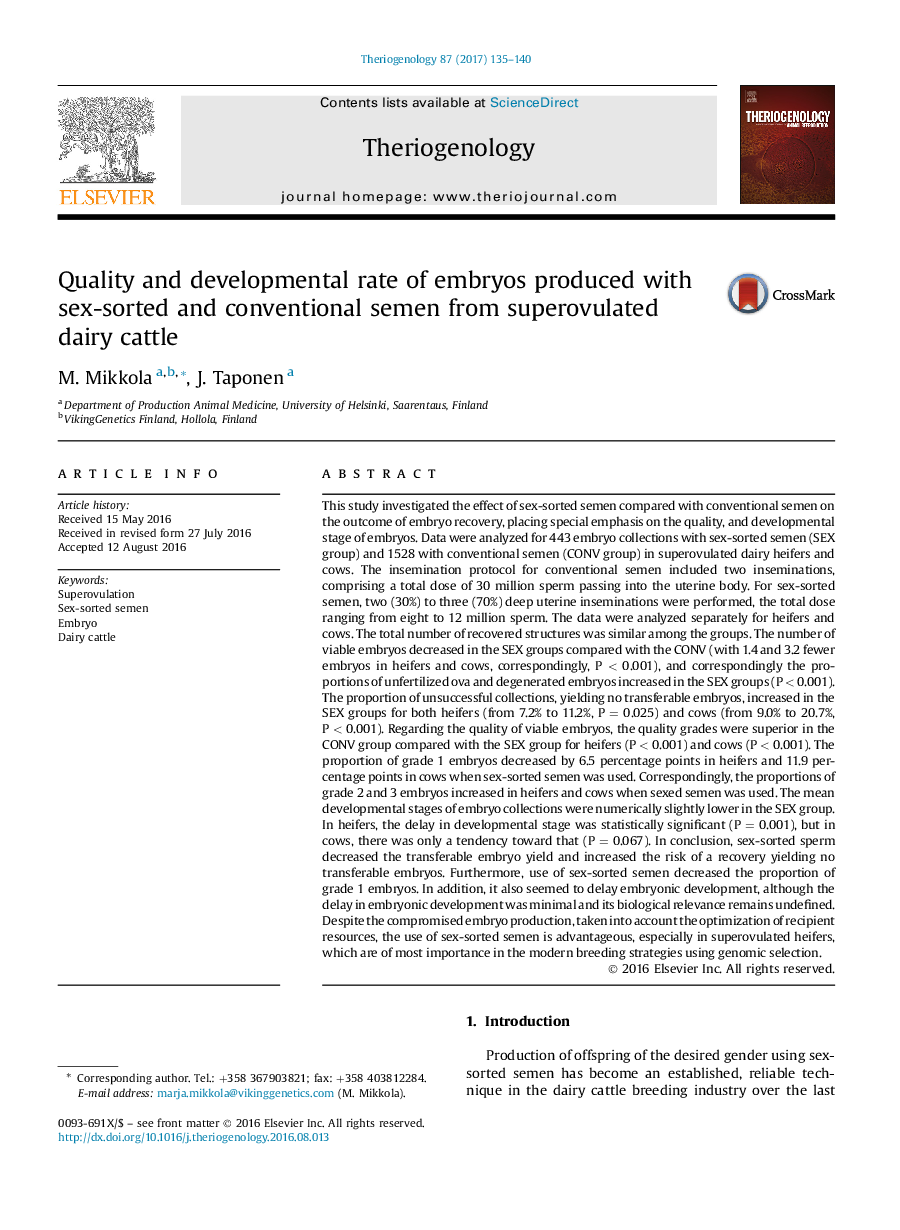| کد مقاله | کد نشریه | سال انتشار | مقاله انگلیسی | نسخه تمام متن |
|---|---|---|---|---|
| 5523328 | 1546082 | 2017 | 6 صفحه PDF | دانلود رایگان |
This study investigated the effect of sex-sorted semen compared with conventional semen on the outcome of embryo recovery, placing special emphasis on the quality, and developmental stage of embryos. Data were analyzed for 443 embryo collections with sex-sorted semen (SEX group) and 1528 with conventional semen (CONV group) in superovulated dairy heifers and cows. The insemination protocol for conventional semen included two inseminations, comprising a total dose of 30 million sperm passing into the uterine body. For sex-sorted semen, two (30%) to three (70%) deep uterine inseminations were performed, the total dose ranging from eight to 12 million sperm. The data were analyzed separately for heifers and cows. The total number of recovered structures was similar among the groups. The number of viable embryos decreased in the SEX groups compared with the CONV (with 1.4 and 3.2 fewer embryos in heifers and cows, correspondingly, PÂ <Â 0.001), and correspondingly the proportions of unfertilized ova and degenerated embryos increased in the SEX groups (PÂ <Â 0.001). The proportion of unsuccessful collections, yielding no transferable embryos, increased in the SEX groups for both heifers (from 7.2% to 11.2%, P = 0.025) and cows (from 9.0% to 20.7%, PÂ <Â 0.001). Regarding the quality of viable embryos, the quality grades were superior in the CONV group compared with the SEX group for heifers (PÂ <Â 0.001) and cows (PÂ <Â 0.001). The proportion of grade 1 embryos decreased by 6.5 percentage points in heifers and 11.9 percentage points in cows when sex-sorted semen was used. Correspondingly, the proportions of grade 2 and 3 embryos increased in heifers and cows when sexed semen was used. The mean developmental stages of embryo collections were numerically slightly lower in the SEX group. In heifers, the delay in developmental stage was statistically significant (P = 0.001), but in cows, there was only a tendency toward that (P = 0.067). In conclusion, sex-sorted sperm decreased the transferable embryo yield and increased the risk of a recovery yielding no transferable embryos. Furthermore, use of sex-sorted semen decreased the proportion of grade 1 embryos. In addition, it also seemed to delay embryonic development, although the delay in embryonic development was minimal and its biological relevance remains undefined. Despite the compromised embryo production, taken into account the optimization of recipient resources, the use of sex-sorted semen is advantageous, especially in superovulated heifers, which are of most importance in the modern breeding strategies using genomic selection.
Journal: Theriogenology - Volume 87, 1 January 2017, Pages 135-140
